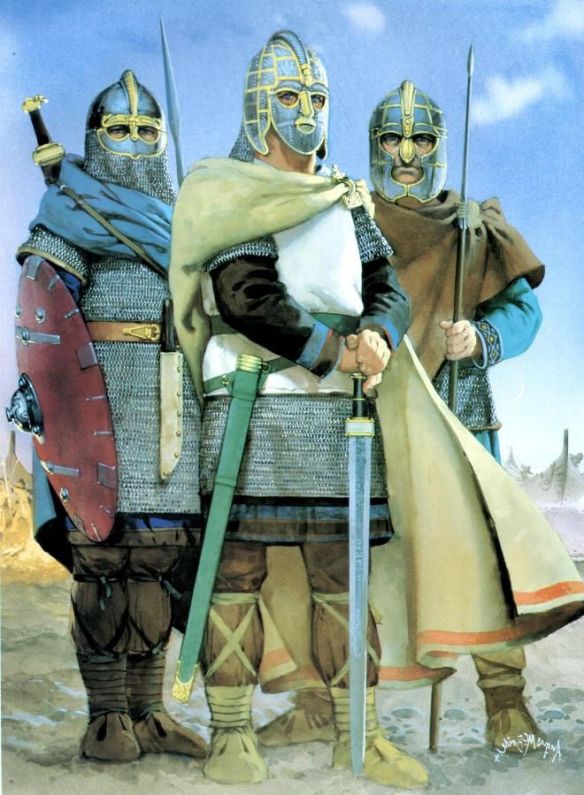The military capabilities of late Anglo-Saxon England appear to have been impressive. The defeat of the Vikings and the conquest of the Danelaw in the ninth and tenth centuries were remarkable administrative and military feats. Later, in the 1040s, both King Sweyn of Denmark and the emperor, Henry III, were keen to obtain English military assistance. Moreover, Edward the Confessor, through Earl Harold’s efforts, was able to reduce the Welsh to subjection with apparent ease in 1063, and this followed Earl Siward’s victory against the Scots and their Norman allies in 1054. Perhaps the greatest achievement of all was Harold’s northern campaign of 1066. Of course, there were defeats, too: England was, after all, conquered by foreign invaders twice during the eleventh century. And on a smaller scale, during the reign of Edward the Confessor, there were frustrating campaigns against the Welsh to set alongside Harold’s victory of 1063. In 1052, for example, Gruffudd ap Llywelyn raided Herefordshire and defeated local forces near Leominster, and in 1055, along with the exiled Earl Aelfgar of Mercia, he overcame local troops who had been made to fight on horseback by their French earl, Ralph of Mantes, and sacked Hereford. However, that the English system was able to cope with and recover from such reverses is good evidence of its resilience and its sophistication.
But where did the men who fought in these campaigns come from? It has been suggested that this period ‘saw the mobilisation of the country and its resources for war to an extent that was not to be repeated until the total wars of the twentieth century’. Unfortunately, however, there is little firm evidence which clearly demonstrates how Anglo-Saxon armies were raised and organised. There was no standing army as such, although the household retainers permanently with the king and each great magnate would have formed the core of any national force. They might be called housecarls in the sources, but this Scandinavian term does not denote any difference of function or status from the English thegn. All household troops were provided by their lord with food, lodging and wages. They would hope to receive land in due course. Below this level was the bulk of the national army, or the fyrd. The ‘common burdens’ of bridge and fortress-work and service in the fyrd were imposed on all freemen by English kings in the eighth century. Military service was also due from those who had been granted ‘bookland’ (that is, land granted in perpetuity, not loaned) by the king. How much service largely depended upon the size of the estate in question. Obligations were based upon the hideage assessment of each estate: in Berkshire before 1066, for example, it was understood that every five hides would provide one soldier for the army or one sailor for the fleet who would serve at his own expense for sixty days. This system or something like it may have operated more widely across England. If England in 1066 comprised roughly 80,000 hides, as has been suggested, then this would represent no fewer than 15,000 men on the basis of the Berkshire obligation. In practice arrangements were probably more flexible than this. Holders of larger estates, for example, might be expected to bring a quota of followers calculated either according to so many men per hide or on the basis of an individual arrangement. Much smaller forces might be summoned to act within specific areas.
The late Anglo-Saxon military system has come in for criticism from historians in the past, who have been keen to emphasise the modernity and sophistication of the Norman military machine. The fact that King Harold had to disband his forces in September 1066, for example, has been taken as evidence of the problems inherent in the system. In fact, Harold did well to keep his force in the field as long as he did. What is more, he was probably able to call out the fyrd at least three times in 1066, and even if his army was not as large as it might have been at Hastings, and even if it contained no cavalry, it was still nearly too much for the Normans. The strain under which the system operated in 1066 was huge, and that it almost overcame the problems it faced is surely testimony to that system’s strengths, not its weaknesses. The military system Edward the Confessor and Harold had at their disposal was ‘well-organised, well-equipped and a reflection of the intelligence and power to be found in other aspects of the late Anglo-Saxon state’
The best evidence of the overall sophistication and coherence of late Anglo-Saxon government is, perhaps paradoxically, Domesday Book, compiled at the end of William the Conqueror’s reign. The Domesday Book, it is worth emphasising here that all of the work of the survey was carried out in 1086 using the Old English administrative system and the available records of Old English government. To facilitate the survey, the country was divided into seven or eight separate circuits, each made up of a group of shires. The great landholders organised their information by subdividing their lands into hides, and their returns to the government contained information which they must already have had written down for their own purposes. Next, local people from each hundred or wapentake were formed into juries and gave evidence at the shire court as to the accuracy of the returns which had been submitted. The survey was probably completed as early as August 1086, a remarkable achievement for such an ambitious project, and further evidence of ‘the responsiveness of the inherited territorial framework of county and hundred’. Hides, shires, hundreds, wapentakes, juries: these Anglo-Saxon creations were still central to the organisation and administration of England twenty years after Hastings, and they remained so for centuries after that. And the fact that the shires survived until 1974 as the basic units of local government in England speaks volumes for their toughness and effectiveness as an institution.
